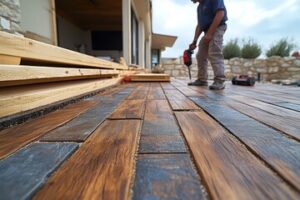Landscaping is the art of arranging plants, trees, and other features on a property to enhance its appearance and function. It raises property value, improves usability, and supports environmental conservation.

A well-designed landscape provides an environment where you can relax, unwind from the stresses of daily life, and reconnect with nature. Proper landscape construction creates a seamless transition between your indoor and outdoor living spaces. Visit https://www.jupiterlandscaping.net/ to learn more.
A well-designed outdoor landscape adds value to a home or commercial property. It also provides a place for recreation and relaxation, improving the quality of life in urban areas. A professional landscape designer can help you create a beautiful, functional yard or garden.
The most important consideration when creating a landscaping plan is the overall aesthetic of the project. The design should complement the style of the house and reflect the personality of the owner. It should also incorporate the natural features of the environment, such as soil conditions and sun exposure.
Landscape designers use a variety of tools and techniques to create attractive, sustainable outdoor spaces. They must have a thorough understanding of horticulture, site analysis, planting design, and construction methods. In addition, they should be familiar with the elements and principles of design, including color, line, texture, form, and scale.
Choosing the right materials is also crucial. The right choice will withstand wear and tear and maintain its beauty over time. For example, a porous stone patio will age differently than a wooden deck. Choosing the right plants is equally important. It is important to choose plant species that thrive in the local climate and soil conditions. Creating a balance of colors, shapes, and sizes is vital to a successful landscape design.
Another important consideration is the use of lines in a landscape. Straight lines create a formal character and are often associated with symmetrical balance. Curved lines create a more organic character and are usually associated with asymmetrical balance. Line can also be used to connect spaces through the use of repetition or focal points.
Landscape designers must also be skilled in hardscaping, which includes the creation of features such as walkways and retaining walls. This requires a strong knowledge of construction techniques and the ability to visualize how different components will work together. It is also important for landscape designers to be able to identify and understand different plant species, as well as their growth habits and maintenance needs. This helps ensure that the plant selection will be compatible with the surrounding environment and climate, which increases the long-term success of the landscape design.
Lawn Care
Lawn care is an important aspect of landscaping and includes activities such as mowing, fertilizing, watering, trimming shrubs, weed control, and more. Landscapers are able to create healthy and beautiful lawns through these services that are tailored to each customer’s specific needs. They can also perform soil tests to determine nutrient levels and amend as needed. Additionally, they are able to help with insect and disease management, weed control, and turf establishment and improvement.
Landscaping also includes hardscape features, which are nonliving components of a garden or yard such as patios, walkways, retaining walls, and fountains. These can be constructed from a wide range of materials, including wood, stone, concrete, and brick. Landscaping professionals often design and construct these elements to complement the natural environment and add visual interest to a property.
Hardscaping is typically more labor intensive than softscaping, but it can add significant value to a home or business. It is also a great way to increase the amount of green space in an urban or suburban area.
Unlike gardening, which has more of a focus on personal enjoyment and growing food, landscaping is more about the aesthetics and functionality of outdoor spaces. Landscapers can use plants and other living things to enhance a space, but they also have the ability to alter the terrain of an area through grading and other changes in elevation.
A well-maintained lawn is the cornerstone of any good landscaping design. In addition to regular mowing, trimming, and watering, a proper lawn care routine includes frequent core aeration. This process removes plugs of thatch and soil from your yard, alleviating soil compaction and allowing water, nutrients, and oxygen to reach grass roots more easily. It is also recommended to regularly apply mulch, which helps conserve moisture and reduce weed growth. Finally, a comprehensive pest management plan is essential for maintaining a healthy and lush lawn. Pests such as grubs, beetles, caterpillars, and chinch bugs can quickly destroy a healthy lawn, so it is vital to prevent them from damaging your property with the help of herbicides and other chemical treatments.
Irrigation
Irrigation is the process of providing water to a landscape. This is important for a variety of reasons, including helping to keep plants healthy and alive, and it can be used in both commercial and residential settings. Irrigation can be done manually, using a hose or sprinklers, or automatically, through an irrigation system. Regardless of the type of irrigation used, it is essential to have a well-thought-out plan for irrigating your landscape.
A good irrigation system can save you a lot of time by automating the process and ensuring that your landscape is properly hydrated. A professional system will also be customized to fit the specific needs of your property’s landscape, so that each plant receives the exact amount of water that it requires. This minimizes waste and promotes healthier, happier plants.
One of the most important things to remember when installing an irrigation system is that it must be well-maintained in order to continue working effectively. This is because a poorly maintained system can lead to problems such as overwatering, runoff, and excessive water usage, which can damage the health of your plants and reduce their overall appearance.
If you notice any issues with your irrigation system, such as unexplained higher water bills or strange hissing noises, it is crucial to contact a landscaping professional as soon as possible. Irrigation issues should be addressed as soon as they arise, as this will help prevent further damage to your landscape and increase the longevity of your investment.
While it may seem like a costly investment at first, an irrigation system can actually save you money in the long run by improving the efficiency of your landscape and reducing water wastage. In addition, it can help protect your initial landscaping investment by minimizing the need for expensive repairs and replacements. Hittle Landscaping offers affordable pricing options, so that business owners and commercial property managers can get the best possible value from their landscape investments. Contact us today to learn more about our services.
Xeriscaping
A xeriscape (pronounced ZEER-is-cape) is a landscape that minimizes water usage. This doesn’t mean a dry garden full of cactus and rocks, but it does involve planting drought-tolerant plants and using soil and mulch that conserves moisture. The concept of a xeriscape is to create a landscape that is lush, colorful, and alive, while keeping the need for irrigation low.
One of the first steps in xeriscaping is to improve your soil. This involves adding organic matter to the topsoil to retain moisture and add nutrients, as well as incorporating a layer of mulch around your plants. Mulch minimizes evaporation and helps maintain consistent soil temperature, both of which will help reduce your water usage. Organic mulches include shredded bark, compost, rotted manure, pine needles, grass clippings, and leaves. Incorporating a layer of mulch into your landscape also helps minimize the amount of water runoff from your property into streets, sidewalks, and nearby buildings and homes, thereby protecting the environment and preserving the quality of reservoirs, water treatment facilities, and aquifers.
The next step in xeriscaping is to identify and divide your yard into hydrozones, or areas with similar water requirements. You can do this by observing which areas receive the most sun during the day and which ones are shady. From there, choose drought-tolerant plants suited to your yard’s specific conditions, such as Texas redbud trees that grow 10 to 20 feet tall with pink, white, or purple flowers in summer and trailing lantana that blooms yellow and orange in summer.
Lastly, you should install water-wise targeted irrigation to ensure that only the needed amounts of water are being used. This could include drip irrigation, soaker hoses, or spray irrigation. In addition, you should limit turf grass areas and replace them with groundcovers or hardscapes to prevent excessive watering.
By implementing the seven principles of xeriscaping, you can drastically cut your water usage and help protect the environment. Using these techniques in your landscape can lower water bills and eliminate the need for chemical treatments. In turn, this will protect the quality of the water in reservoirs, water treatment plants, and aquifers, so that you can continue enjoying your lawn, gardens, and other outdoor spaces.






